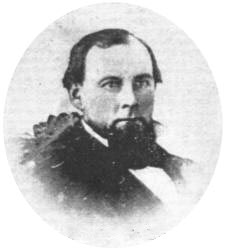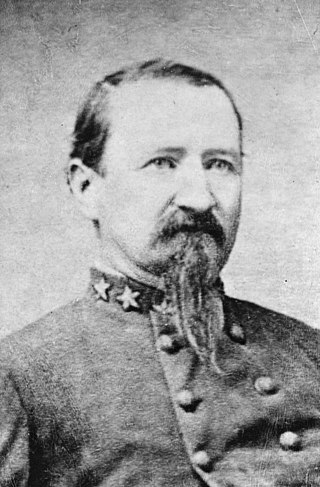
Thomas Saltus Lubbock was a Texas Ranger and colonel in the Confederate army during the American Civil War.
The Battle of Brentwood was a battle during the American Civil War on March 25, 1863, in Williamson County, Tennessee at Brentwood, Tennessee.

Thomas Taylor Munford was an American farmer, iron, steel and mining company executive and Confederate colonel and acting brigadier general during the American Civil War.

Pinckney Downie Bowles was a lawyer, county prosecutor, probate judge, and a Confederate military officer during the American Civil War.

Colton Greene was an officer of the Confederate States Army who commanded cavalry in the Trans-Mississippi Theater of the American Civil War. After the Civil War Greene pursued several successful civic projects and public functions in Memphis, Tennessee.
The 3d Arkansas Cavalry Regiment (1861–1865) was a Confederate Army Cavalry regiment during the American Civil War.

During the American Civil War, the state of Illinois was a major source of troops for the Union Army, and of military supplies, food, and clothing. Situated near major rivers and railroads, Illinois became a major jumping off place early in the war for Ulysses S. Grant's efforts to seize control of the Mississippi and Tennessee rivers. Statewide, public support for the Union was high despite Copperhead sentiment.

Tyree Harris Bell was a Confederate States Army brigadier general, during the American Civil War.

Horace Randal was a Confederate States Army colonel during the American Civil War. Randal was mortally wounded while commanding a brigade at the Battle of Jenkins' Ferry, Arkansas on April 30, 1864, dying two days later. Confederate President Jefferson Davis did not act upon a request made by General E. Kirby Smith on November 8, 1863, to promote Randal to brigadier general. After Randal's performance at the Battle of Mansfield, General Smith, as the Confederate commander of the Trans-Mississippi Department, assigned Randal to duty as a brigadier general on April 13, 1864. Randal was not officially promoted. Jefferson Davis subsequently revoked Smith's appointment of Randal as a brigadier general.

Henry Marshall Ashby was a Confederate States Army colonel during the American Civil War. Although he commanded a brigade from June 1864 and a division at the Battle of Bentonville and through the surrender of the Confederate force under the command of General Joseph E. Johnston, he was never appointed a brigadier general by Confederate President Jefferson Davis or confirmed as a general officer by the Confederate Senate.

James Hagan was a United States Army captain during the Mexican–American War and a Confederate States Army colonel during the American Civil War. He was a prosperous businessman and planter at Mobile, Alabama, between the wars.
Moses Wright Hannon was a Confederate States Army colonel during the American Civil War. In August 1864, he was assigned to duty as an acting brigadier general by General John Bell Hood, subject to appointment by Confederate President Jefferson Davis and confirmation by the Confederate Senate. Although Hannon commanded a brigade in the cavalry corps of the Army of Tennessee and in Major General Joseph Wheeler's cavalry corps from June 1864 until the end of the war, he never was officially appointed by Jefferson Davis and confirmed by the Confederate Senate to brigadier general rank.

Francis Marion Walker was a Confederate States Army officer during the American Civil War. He was killed while commanding a brigade at the Battle of Atlanta of July 22, 1864, one day before his commission as a brigadier general in the Confederate Army was delivered.

Charles Constantine Crews was an attorney, physician, railroad executive and Confederate Colonel in the American Civil War. Between 1862 and 1865, he participated in most of the Western Theater cavalry campaigns of Major General Joseph Wheeler, initially leading the 2nd Georgia Cavalry and eventually a cavalry brigade.
Gideon W. Thompson was a colonel in the Missouri State Guard and the Confederate Army during the American Civil War. He assumed command on the field after the fall of Brigadier General John T. Hughes at the First Battle of Independence.

The Battle of Coffeeville, fought December 5, 1862, was a military engagement of the American Civil War fought near Coffeeville, Mississippi.
Isaac Stearns Jr., of Billerica, Massachusetts, was a sergeant in the American Revolutionary Army. On April 19, 1775, he was among the minutemen who rallied at the first alarm at the onset of the Battles of Lexington and Concord. He was also a member of a group of forty men, led by Ethan Allen, that captured Fort Ticonderoga. Stearns contributed £10 to a fund established to hire men to serve in the Revolutionary Army.

Thomas Hamilton McCray was an American inventor, a businessman and a Confederate States Army officer during the American Civil War.

William Sugars McLemore (1830–1908) was a circuit judge for Tennessee and a colonel in the Confederate States Army during the American Civil War.
The 4th Tennessee Cavalry Regiment was a cavalry regiment that served in the Confederate States Army during the American Civil War.













